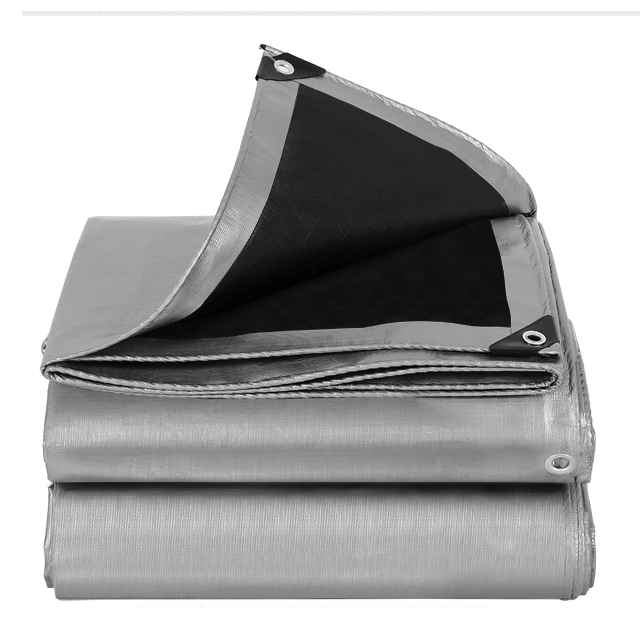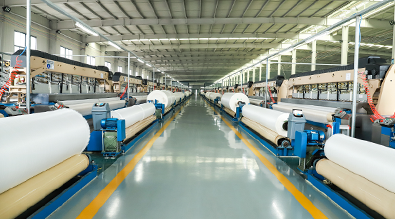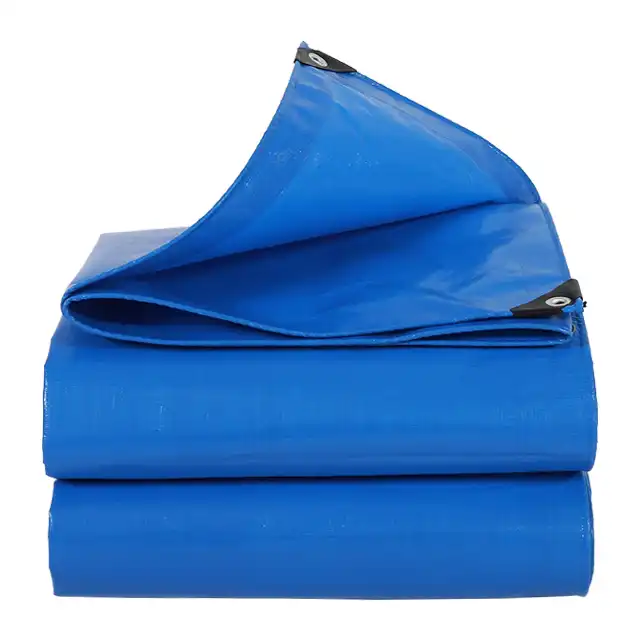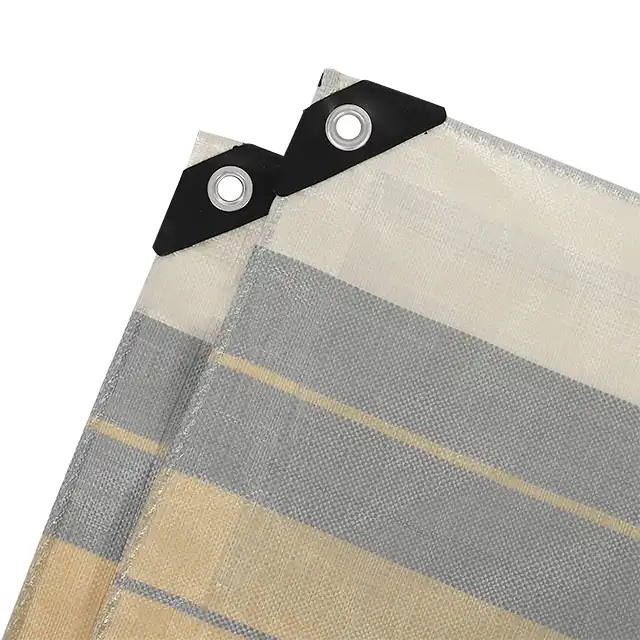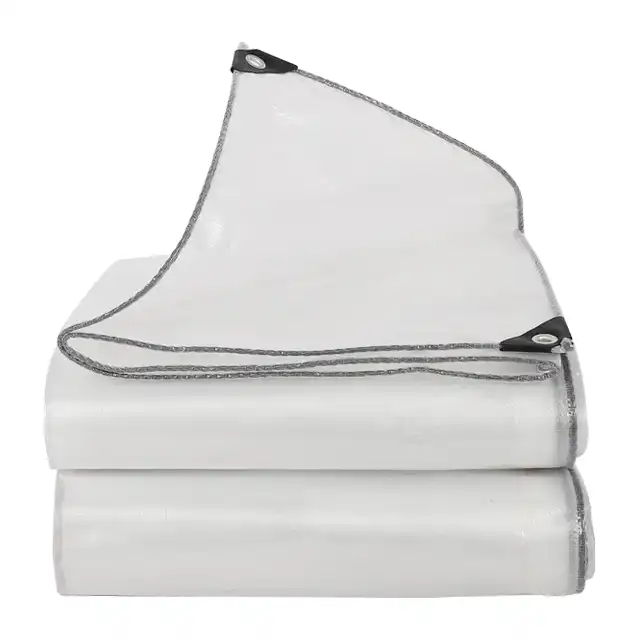How to Assess the Quality and Durability of Tarpaulins?
Picture this scenario: You've invested in what appeared to be a high-quality tarpaulin for your construction project, only to discover it's failing after just a few months of use—torn edges, compromised waterproofing, and UV degradation leaving you with costly equipment damage and project delays. This frustrating situation highlights why knowing how to properly assess tarpaulin quality and durability is crucial for anyone seeking reliable protective covering solutions. Understanding the key quality indicators will save you both money and headaches while ensuring your investment delivers long-lasting performance in demanding applications.
Understanding Tarpaulin Material Composition and Construction

The foundation of any high-quality tarpaulin lies in its material composition and construction methodology. Modern PE tarpaulins are manufactured using high-density polyethylene (HDPE) woven fabric combined with low-density polyethylene (LDPE) coating, creating a robust dual-layer protection system. The weaving process involves creating cross-woven strands that provide the base strength, while the coating process adds waterproofing and UV protection capabilities. Premium tarpaulin quality begins with the selection of raw materials. High-grade polyethylene fibers are extruded using advanced machinery, with yarn thickness ranging from 400D to 2500D depending on the intended application. The extrusion process must maintain consistent diameter and tensile strength throughout the production run to ensure uniform performance across the entire tarpaulin surface.
-
Fabric Weaving Density and Pattern Analysis
The weaving density, measured in mesh count, directly correlates with the tarpaulin's overall strength and durability. Professional-grade tarpaulins typically feature mesh counts between 10x10 to 14x14, indicating the number of warp and weft threads per inch. Higher mesh counts generally provide superior tear resistance and dimensional stability, making them ideal for heavy-duty applications requiring extended service life. When evaluating fabric weaving patterns, examine the consistency of the weave structure. Quality tarpaulins exhibit uniform thread spacing and tension throughout the material, without loose or overly tight areas that could create weak points. The weaving process should produce a balanced fabric where both warp and weft threads contribute equally to the overall strength characteristics.
Evaluating Weight and Thickness Specifications
Weight specifications serve as a primary indicator of tarpaulin quality and expected performance levels. Professional tarpaulins are typically categorized by their weight per square meter, ranging from lightweight 65gsm options for temporary applications to heavy-duty 280gsm variants designed for permanent installations. The weight directly reflects the amount of raw material used in construction and correlates strongly with durability expectations. Thickness measurements, expressed in mils (thousandths of an inch), provide another critical assessment parameter. Quality tarpaulins typically range from 7 to 12 mils thickness, with thicker options offering enhanced puncture resistance and longevity. However, thickness alone doesn't guarantee superior performance—the coating uniformity and adhesion quality are equally important factors.
-
Understanding GSM Ratings and Performance Correlation
GSM (grams per square meter) ratings provide standardized measurement for comparing different tarpaulin options. Light-duty applications may require 100-120gsm tarpaulins, while medium-duty uses typically demand 140-180gsm specifications. Heavy-duty industrial applications often necessitate 200-280gsm tarpaulins to withstand harsh environmental conditions and mechanical stress. The relationship between GSM ratings and actual performance depends on the manufacturing quality and material selection. A well-constructed 150gsm tarpaulin from a reputable manufacturer may outperform a poorly made 200gsm alternative, emphasizing the importance of evaluating multiple quality factors rather than relying solely on weight specifications.
Assessing Waterproofing and Weather Resistance Properties
Waterproofing performance represents one of the most critical aspects of tarpaulin quality assessment. Professional-grade tarpaulins should demonstrate complete water resistance under normal operating conditions, with water beading on the surface rather than penetrating the material. The coating process involves applying specialized polymer layers that create a barrier against moisture infiltration while maintaining fabric breathability where required. UV resistance capabilities determine the tarpaulin's ability to withstand prolonged sun exposure without degradation. Quality manufacturers incorporate UV treatment ranging from 1% to 7% concentration into their products, providing protection against harmful solar radiation that can cause material brittleness and color fading. The UV treatment should be evenly distributed throughout the coating layer to ensure consistent protection across the entire surface area.
-
Testing Waterproof Performance Standards
Practical waterproof testing involves applying controlled water pressure to the tarpaulin surface and monitoring for any seepage or penetration. Professional-grade products should withstand water pressure equivalent to heavy rainfall conditions without compromising their protective capabilities. The hydrostatic head test, measuring water column height the material can resist, provides quantifiable waterproofing performance data. Long-term waterproofing durability requires examining the coating's adhesion to the base fabric and its resistance to mechanical wear. Quality tarpaulins maintain their waterproof properties even after repeated folding, stretching, and exposure to environmental stresses. The coating should remain flexible and intact without cracking or delaminating from the substrate material.
Examining Seam Construction and Reinforcement Features
Seam construction quality often determines the overall reliability and service life of tarpaulin products. Professional manufacturing processes employ heat-sealing techniques that create waterproof seams with strength characteristics matching or exceeding the base material. The seam width should be consistent throughout the product, typically measuring 12-25mm depending on the application requirements and material thickness. Reinforcement features include strengthened corners, edge hems, and strategic placement of additional material layers in high-stress areas. Quality tarpaulins incorporate brass or rust-resistant grommets spaced at regular intervals, typically every 18-24 inches along the perimeter. The grommet attachment process should create secure anchor points without compromising the surrounding material integrity.
-
Grommet Quality and Placement Standards
Grommet quality assessment involves examining both the material composition and installation technique. Professional-grade grommets utilize brass or stainless steel construction to prevent corrosion and ensure long-term reliability. The grommet installation should create a reinforced attachment point that distributes stress across a broader area, preventing tear propagation under load conditions. Proper grommet placement follows industry standards for spacing and positioning to optimize load distribution and user convenience. Corner grommets should be positioned to allow efficient tie-down configurations while edge grommets provide intermediate attachment points for various securing methods. The grommet diameter should accommodate standard rope and fastener sizes commonly used in the target applications.
Color Stability and UV Protection Assessment
Color stability serves as a visual indicator of UV protection effectiveness and overall material quality. Premium tarpaulins maintain their original color appearance even after extended outdoor exposure, demonstrating superior UV inhibitor performance and coating stability. Color fading typically indicates UV degradation that compromises both aesthetic appeal and structural integrity over time. UV protection assessment involves understanding the specific additives and treatment processes used during manufacturing. Quality tarpaulin producers incorporate UV stabilizers directly into the polymer matrix rather than relying solely on surface treatments that may wear away with use. The protection level should be appropriate for the expected service environment and duration requirements.
-
Long-term Color Retention Standards
Professional tarpaulin applications often require specific color retention standards to maintain visibility and identification purposes. Industrial safety applications may demand high-visibility colors that retain their brightness throughout the service life, while agricultural uses might prioritize colors that blend with natural environments while maintaining protective capabilities. Color retention testing involves controlled exposure to accelerated aging conditions that simulate years of outdoor service in compressed timeframes. Quality products demonstrate minimal color shift and maintain acceptable appearance standards even under harsh environmental conditions including extreme temperatures, humidity, and chemical exposure.
Conclusion
Assessing tarpaulin quality and durability requires comprehensive evaluation of material composition, construction methods, weight specifications, waterproofing capabilities, seam construction, and UV protection features. By understanding these critical factors, buyers can make informed decisions that ensure their investment provides reliable long-term performance and value.
Cooperate with Linyi Shengde Plastic Co., Ltd.
Linyi Shengde Plastic Co., Ltd. stands as the leading China tarpaulin factory and China tarpaulin manufacturer, established in 2003 with over two decades of expertise in producing high-quality PE tarpaulins. As a trusted China tarpaulin supplier offering China tarpaulin wholesale solutions, our company maintains registered capital of CNY 80 million and operates a 60,000 square meter manufacturing facility equipped with advanced production lines capable of 100+ tons daily output.
Our reputation as a premier China tarpaulin manufacturer stems from unwavering commitment to quality management and innovation. We maintain ISO 9001:2015 certification and have established partnerships with international organizations including UNHCR, IOM, ICRC, and UNICEF, demonstrating our capability to meet the most demanding quality standards. Our research and development team continuously develops new solutions, including ultra-wide width tarpaulin products, fire prevention features, and enhanced waterproof capabilities.
With over 600 skilled workers and state-of-the-art equipment including 400+ Korea-imported water-jet looms and advanced coating machines, we ensure consistent High Quality tarpaulin production. Our tarpaulin for sale includes comprehensive product ranges from 65gsm to 280gsm weights, available in any color with competitive tarpaulin price options. For premium tarpaulin solutions backed by proven manufacturing excellence, contact us at info@shengdetarp.com to discuss your specific requirements and receive detailed quotations.
FAQ
Q: What is the most important factor when assessing tarpaulin quality?
A: Material composition and weaving density are crucial, with mesh count and coating uniformity being key quality indicators.
Q: How can I test waterproof performance of tarpaulins?
A: Pour water on the surface and observe if it beads off without penetration, or conduct hydrostatic pressure tests.
Q: What GSM rating should I choose for heavy-duty applications?
A: Heavy-duty uses typically require 200-280gsm tarpaulins with appropriate UV treatment and reinforcement features.
Q: How do I evaluate UV protection effectiveness in tarpaulins?
A: Look for UV treatment percentages (1-7%) and examine color stability after extended sun exposure as quality indicators.
References
1. "Tarpaulin Material Standards and Quality Assessment Methods" - Industrial Textile Research Institute, Technical Publication Series
2. "Waterproof Coating Technologies for Synthetic Fabrics" - Dr. Michael Harrison, Polymer Science Journal
3. "UV Protection in Outdoor Textile Applications" - International Standards Organization, Material Testing Guidelines
4. "Quality Control Protocols for PE Woven Fabric Manufacturing" - Textile Manufacturing Association, Best Practices Manual
